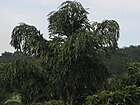Note: This is a project under development. The articles on this wiki are just being initiated and broadly incomplete. You can Help creating new pages.
Caryota urens - Sritalah
Sritalah is a large palm tree that can be found growing in the evergreen forests of the western ghats and planted freely throughout India. Traditionally the tree has been used to make toddy and starch is extracted from the inner stem.
Uses
Parts Used
Chemical Composition
Common names
| Language | Common name |
|---|---|
| Kannada | Bagani mara, Bagini, Bagni, Baina, Baine, Bainemara, Baini |
| Hindi | Ban-khajur, Mari, Mari ka jhat, Marikajhad |
| Malayalam | Anapana, Anapanna, Anapanne, Anappana, Chundapana |
| Tamil | Ataku, Atakumaram, Atam, Kuntalapanai, Kuntar panai |
| Telugu | Bakini, Chirugu, Chirugu chettu, Cirugu, Gukatad, Jeeluga, Jeeluga chettu |
| Marathi | NA |
| Gujarathi | NA |
| Punjabi | NA |
| Kashmiri | NA |
| Sanskrit | Hoajavriksha, Dirgha, Mada, Madadruma, Madyadru, Madyadruma, Mohakari, Rajju, Sritalah, Vitanaka |
| English | Fishtail palm |
Properties
Reference: Dravya - Substance, Rasa - Taste, Guna - Qualities, Veerya - Potency, Vipaka - Post-digesion effect, Karma - Pharmacological activity, Prabhava - Therepeutics.
Dravya
Rasa
Madhura (Sweet)
Guna
Guru (Heavy)
Veerya
Sheeta (cold)
Vipaka
Karma
Pitta
Prabhava
Habit
Identification
Leaf
| Kind | Shape | Feature |
|---|---|---|
| Bipinnate | alternate | 4-6 m long; pinnae 5-7 pairs, to 1.5 m long; leaflets broadly cuneate, fan-shaped, 12-20 cm long, 7-10 cm wide at wider portion, raemorse at apex, many ribbed. |
Flower
| Type | Size | Color and composition | Stamen | More information |
|---|---|---|---|---|
| Monoecious | Spadix | Yellow | Many | Spadix interfoliar, shortly peduncled, much branched, pendulous, to 4 m long; spathes few, 40-50 cm long. Flowers many, in triads with female flower in the middle. Sepals 3, rounded, imbricate. Petals linear-oblong, valvate. Stamens many. Ovary 3-celled, 3-gonous; ovule 1-per locule. |
Fruit
| Type | Size | Mass | Appearance | Seeds | More information |
|---|---|---|---|---|---|
| 2 cm across | globose, reddish purple; seeds plano-convex, subreniform. | {{{5}}} | {{{6}}} |
Other features
List of Ayurvedic medicine in which the herb is used
Where to get the saplings
Mode of Propagation
How to plant/cultivate
Seed - At room temperature the seeds remain viable for 30 - 90 days, depending on storage conditions. An experiment in Sri Lanka on the effect of seed storage and exposure to sunlight revealed a germination rate of 99% for seeds sown after 30-day storage in a dark room. Seed germinate in 2-4 months. Seedlings can tolerate sun while quite small. [4]
Commonly seen growing in areas
Photo Gallery
References
External Links
- Ayurvedic Herbs known to be helpful to treat Arthritis
- Ayurvedic Herbs known to be helpful to treat Burning sensation
- Ayurvedic Herbs known to be helpful to treat Migraine
- Ayurvedic Herbs known to be helpful to treat Snake bites
- Herbs with Leaves used in medicine
- Herbs with Fruits used in medicine
- Herbs with Sap used in medicine
- Herbs with common name in Kannada
- Herbs with common name in Hindi
- Herbs with common name in Malayalam
- Herbs with common name in Tamil
- Herbs with common name in Telugu
- Herbs with common name in Sanskrit
- Herbs with common name in English
- Habit - Tree
- Index of Plants which can be propagated by Seeds
- Herbs that are commonly seen in the region of Tropical area
- Herbs that are commonly seen in the region of Sub Tropical area
- Herbs
- Plants of western ghats
- Tree
- Ayurvedic herbs that don't have seed photos
- Arecaceae




